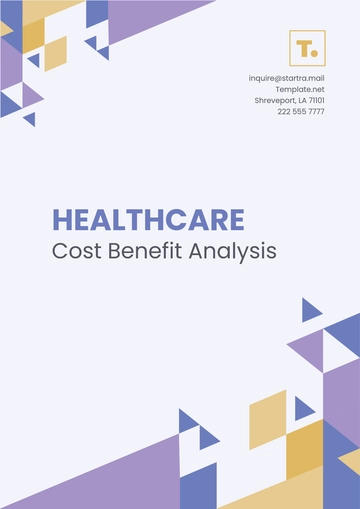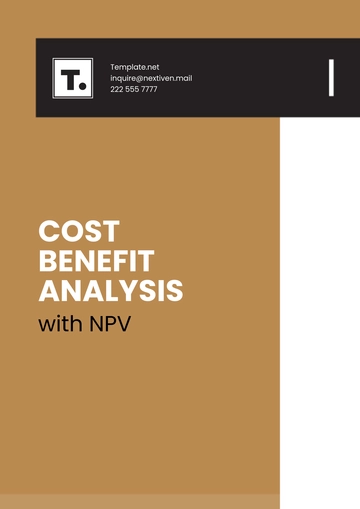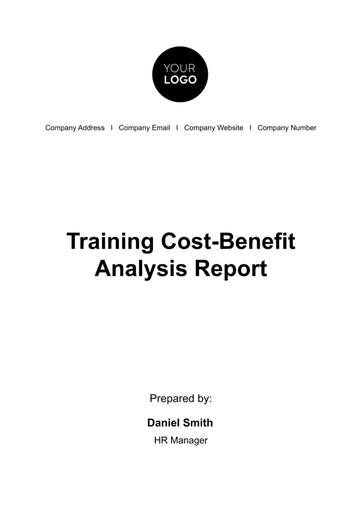Free Workplace Incident Financial Analysis

I. Introduction
This analysis evaluates the financial impact of a recent workplace incident at Your Company Name. The incident involved equipment malfunction leading to operational downtime and employee injury. This report assesses direct and indirect costs, potential revenue loss, and long-term financial implications.
Incident Overview:
On [Date], a critical malfunction occurred within the production unit's machinery. At approximately [Time], a failure in the conveyor belt system led to a cascading effect, resulting in substantial equipment damage and injuries to two employees. This incident not only disrupted the operational flow but also necessitated immediate medical and technical intervention.
Affected Departments/Units:
The incident's epicenter was the production unit, specifically the assembly line. The disruption extended beyond the immediate area, impacting the logistics and supply chain departments, which experienced significant delays in product distribution and a consequent backlog. These delays have potential ramifications for client satisfaction and timely order fulfillment.
Secondary Impacts:
The incident's ramifications were felt company-wide, necessitating immediate responses from various departments. The human resources department was propelled into managing workers' compensation claims and coordinating support for the injured personnel. Simultaneously, the health and safety department was charged with a critical review and overhaul of existing safety protocols.
Furthermore, the incident underscored the need for a revaluation of machinery maintenance and emergency response strategies, highlighting broader systemic issues that need addressing to enhance workplace safety and efficiency.
II. Direct Costs Analysis
This section presents a detailed financial breakdown of the direct costs incurred from the incident, focusing on specific expense categories. The costs are tabulated to provide a clear and concise overview, aiding in the comprehensive analysis of the incident's immediate financial impact.
A. Medical Expenses
The total medical expenses incurred for the treatment of the injured employees amounted to [$15,000.] This includes emergency care, hospitalization, and follow-up treatments.
Expense Category | Cost |
Emergency Care | $5,000 |
Hospitalization | |
Follow-up Treatments | |
Total |
B. Damage Repair Costs
Repair costs for the damaged machinery and facility repairs are estimated at [$25,000]. This includes parts replacement and labor charges.
Expense Category | Cost |
Parts Replacement | $15,000 |
Labor Charges | |
Facility Repairs | |
Total |
C. Compensation and Benefits
Worker's compensation claims and disability benefits for the injured employees are projected to be around [$10,000].
Expense Category | Cost |
Worker's Compensation | $6,000 |
Disability Benefits | |
Total |
III. Indirect Costs Analysis
The Indirect Costs Analysis delves into the less apparent but significant financial impacts of the incident. This section provides a detailed breakdown of the costs related to lost productivity, training and replacement of personnel, and administrative expenses, presented in a clear, tabulated format for a comprehensive understanding.
A. Lost Productivity
The incident resulted in a production downtime of [48 hours]. The estimated financial impact due to lost productivity is approximately [$30,000].
Time Frame | Lost Hours | Average Hourly Rate | Total Cost |
Immediate Downtime | 16 hours | $50 | $800 |
Reduced Output | |||
Ongoing Disruptions | |||
Total |
B. Training and Replacement
Hiring temporary workers and training them to fill in for the injured employees will incur costs around [$5,000].
Requirement | Number of Personnel | Training Cost per Person | Total Cost |
Temporary Replacement Workers | 2 | $500 | $1,000 |
New Employee Training | |||
Total |
C. Administrative Expenses
Additional administrative work related to the incident, including investigation and documentation, is estimated to cost [$3,000].
Activity | Hours Spent | Hourly Administrative Rate | Total Cost |
Incident Investigation | 20 hours | $40 | $800 |
Reporting and Documentation | |||
Legal and Compliance Activities | |||
Total |
IV. Insurance and Legal Costs
This section carefully examines the financial consequences associated with insurance adjustments and legal proceedings following the incident. It presents a tabulated analysis of the increased insurance premiums and anticipated legal costs, providing a clear financial perspective on these often substantial expenditures.
A. Insurance Premiums
Post-incident, the insurance premiums for the company are expected to increase by [10%], resulting in an additional annual cost of [$8,000].
Insurance Category | Current Annual Premium | Projected Increase | Additional Annual Cost |
Liability Insurance | $80,000 | 10% | $8,000 |
Property Insurance | |||
Worker's Compensation Insurance | |||
Total Increased Cost |
B. Legal Fees and Settlements
Potential legal fees and settlements, considering the severity of the incident, are estimated to be around [$20,000].
Legal Requirement | Estimated Cost |
Attorney Fees | $10,000 |
Settlement Costs | $15,000 |
Regulatory Fines | $5,000 |
Compliance Upgrade Costs | $10,000 |
Total Estimated Legal Costs | $40,000 |
V. Long-Term Financial Impacts
This section delves into the extensive long-term financial implications of the workplace incident, focusing on the subtler yet significant aspects of employee morale and company reputation. These factors often have enduring financial consequences that transcend immediate costs.
A. Impact on Employee Morale and Turnover
The incident has led to a noticeable decline in employee morale, particularly in the affected departments. A survey indicates increased concerns about workplace safety, potentially affecting job satisfaction and productivity.
An estimated [5%] increase in employee turnover is anticipated due to diminished morale. This turnover rate is particularly concerning in skilled positions, where the loss of experienced staff could significantly impact operational efficiency.
The financial burden of this increased turnover includes the costs of recruiting and training new employees. Estimated recruitment costs per employee average [$3,000], while training costs average [$2,000]. With an expected increase of [6] new hires annually due to turnover, the total additional cost is around [$12,000] per year.
Cost Type | Number of New Hires | Cost per Hire | Total Cost |
Recruitment Costs | 6 | $3,000 | $18,000 |
Training Costs | |||
Total |
B. Brand and Reputation Impact
The incident has attracted negative attention, potentially impacting customer perceptions and market confidence. An estimated [5%] decrease in sales over the next quarter is projected, primarily due to this altered perception.
To mitigate this impact, the company will need to invest in reputation management and customer reassurance campaigns. These efforts, including public relations and marketing initiatives, are projected to cost approximately [$20,000].
If unaddressed, the decline in sales could persist or worsen. With a proactive approach, however, it's estimated that sales might return to near-normal levels within two quarters, minimizing the long-term financial impact to around [$50,000].
VI. Preventive Measures and Cost-Benefit Analysis
This crucial section outlines proposed investments in safety enhancements and evaluates their financial viability through a cost-benefit analysis. By quantifying the potential savings against the investment costs, it aids in making informed decisions about implementing preventive measures.
A. Proposed Safety Investments
The plan includes investing in advanced safety technologies for machinery, such as automated shut-off systems, enhanced guards, and improved safety sensors. The estimated cost for these upgrades is approximately [$12,000].
Proposing comprehensive safety training programs for employees, focusing on machinery operation, emergency response, and risk awareness. The budget allocated for developing and delivering these programs is around [$8,000].
The combined cost for these safety improvements totals [$20,000].
B. Cost-Benefit Analysis
The implementation of the proposed safety measures is expected to decrease the likelihood of similar incidents by [50%]. This reduction is based on projected improvements in machinery safety and enhanced employee risk awareness.
By reducing the incidence rate, an estimated annual saving of [$30,000] in direct and indirect costs is anticipated. These savings include reductions in medical expenses, repair costs, and costs associated with lost productivity and legal fees.
Calculating the ROI, the [$20,000] investment in safety measures could potentially yield annual savings of [$30,000] indicating a significant return within the first year of implementation. Additionally, these improvements are expected to enhance long-term employee well-being and further strengthen workplace safety culture.
VII. Summary and Recommendations
The total financial impact of the incident, including direct, indirect, and long-term costs, is estimated to be around [$178,000]. It is recommended to invest in preventive safety measures, review and enhance emergency response protocols, and engage in proactive employee safety training to minimize future risks and financial liabilities.
- 100% Customizable, free editor
- Access 1 Million+ Templates, photo’s & graphics
- Download or share as a template
- Click and replace photos, graphics, text, backgrounds
- Resize, crop, AI write & more
- Access advanced editor
Discover unparalleled convenience with the Workplace Incident Financial Analysis Template from Template.net. This meticulously crafted tool empowers you with editable and customizable features, seamlessly integrating with our Ai Editor Tool. Effortlessly dissect financial data, streamline incident analysis, and make informed decisions with this indispensable resource. Elevate your workflow today!





























